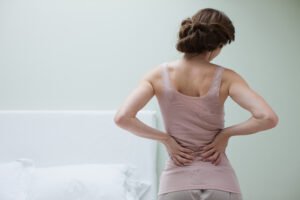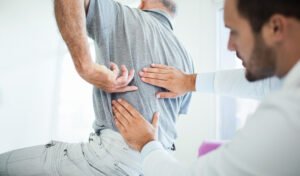Middle back pain, also known as thoracic back pain, is a common condition that affects millions of people worldwide. This article delves into the various aspects of middle back pain, including its causes, treatment options, and preventive measures. Understanding the underlying factors contributing to middle back pain can empower individuals to take charge of their well-being and seek appropriate treatment. So, let’s explore the world of middle back pain and find effective ways to alleviate discomfort and improve overall spinal health.
Contents
- 1 Understanding Middle Back Pain
- 2 Diagnosing Middle Back Pain
- 3 Conservative Treatment Options
- 4 Alternative Therapies for Relief
- 5 Lifestyle Changes for Prevention
- 6 Managing Middle Back Pain at Home
- 7 Medical Interventions
- 8 Combining Therapies for Optimal Results
- 9 Addressing Underlying Conditions
- 10 Preventing Middle Back Pain Through Exercise
- 11 Posture Correction Techniques
- 12 Nutrition and Supplementation
- 13 Conclusion
Understanding Middle Back Pain
Before delving into the causes of middle back pain, it’s essential to understand the anatomy of this region. The thoracic spine consists of twelve vertebrae (T1 to T12) and intervertebral discs that cushion the bones, allowing for flexibility and movement. Ligaments and muscles surrounding the thoracic spine provide stability and support, enabling us to stand, sit, and perform various movements.
Common Causes of Middle Back Pain

Middle back pain can arise from various factors, some of which include:
- Muscle Strain: Overexertion, heavy lifting, or sudden movements can strain the muscles and ligaments of the middle back, leading to pain and discomfort.
- Poor Posture: Prolonged slouching or sitting in an improper position can strain the back muscles and affect spinal alignment.
- Injuries: Traumatic incidents, such as falls or car accidents, can result in middle back pain due to fractures or soft tissue damage.
- Degenerative Conditions: Conditions like osteoarthritis and degenerative disc disease can lead to middle back pain as the spine’s structures undergo wear and tear.
- Herniated Discs: When the gel-like material within a spinal disc leaks out and irritates nearby nerves, it can cause middle back pain.
- Spinal Stenosis: This condition involves the narrowing of the spinal canal, putting pressure on the spinal cord and nerves, leading to pain.
- Scoliosis: Abnormal sideways curvature of the spine can cause muscle imbalances and strain, resulting in middle back pain.
Risk Factors and Prevalence
Middle back pain can affect individuals of all ages, but certain factors may increase the risk of developing this condition. Common risk factors include:
- Age: Middle back pain becomes more prevalent with age, as the spine undergoes degenerative changes over time.
- Sedentary Lifestyle: People with desk-bound jobs or those who lead a sedentary lifestyle are more susceptible to back pain.
- Lack of Exercise: Inadequate physical activity can weaken the back muscles and contribute to pain and stiffness.
- Obesity: Excess weight places additional stress on the spine, increasing the likelihood of back pain.
- Smoking: Smoking reduces blood flow to spinal tissues, hindering their ability to repair and heal properly.
Diagnosing Middle Back Pain
Identifying the root cause of middle back pain is crucial for devising an effective treatment plan. Healthcare professionals use various methods to diagnose the underlying issues. It typically involves the following:
Symptoms and Red Flags
The first step in diagnosis involves evaluating the patient’s symptoms and medical history. Healthcare providers may inquire about the nature of the pain, its duration, and any factors that worsen or alleviate it. Red flags, such as unexplained weight loss, fever, or bowel/bladder dysfunction, may indicate more severe underlying conditions and require immediate medical attention.
Physical Examination and Medical History
During the physical examination, the healthcare provider assesses the patient’s posture, gait, and range of motion. Palpation of the back helps identify tender areas and muscle spasms, providing clues to the source of pain. The patient’s medical history, including previous injuries and existing health conditions, is also valuable in the diagnostic process.
Diagnostic Imaging and Tests
To visualize the spine’s structures and identify potential abnormalities, diagnostic imaging tests may be ordered. These can include X-rays, magnetic resonance imaging (MRI), and computed tomography (CT) scans. Imaging can help detect herniated discs, spinal stenosis, fractures, and other conditions that may contribute to middle back pain.
Conservative Treatment Options
In many cases, middle back pain can be effectively managed through conservative treatment approaches. These non-invasive methods aim to reduce pain and promote healing without resorting to surgery or invasive procedures. Some common conservative treatment options include:
Rest and Ice Therapy
Resting the affected area and applying ice packs can help reduce inflammation and provide relief from acute pain.
Physical Therapy and Exercises
Physical therapy involves targeted exercises and stretches that strengthen the back muscles, improve flexibility, and correct posture.
Pain Medications and Anti-inflammatories
Over-the-counter pain medications and anti-inflammatory drugs can help manage pain and reduce inflammation.
Alternative Therapies for Relief

In addition to conventional treatments, some individuals find relief from middle back pain through alternative therapies. These therapies focus on holistic approaches to healing and pain management. Popular alternative treatments for middle back pain include:
Chiropractic Care
Chiropractic adjustments aim to realign the spine, alleviate pressure on nerves, and promote overall musculoskeletal health.
Acupuncture and Dry Needling
Acupuncture involves the insertion of thin needles into specific points on the body to stimulate energy flow and promote pain relief.
Massage Therapy
Massage therapy can relax tense muscles, improve circulation, and reduce stress, contributing to reduced middle back pain.
Lifestyle Changes for Prevention
Addressing middle back pain is not only about managing existing discomfort but also about preventing its recurrence. Making certain lifestyle changes can significantly reduce the risk of experiencing middle back pain. Here are some helpful tips:
Improving Posture
Maintaining good posture while sitting, standing, and walking can alleviate strain on the back and reduce the risk of pain.
Ergonomics and Workplace Setup
Ensuring an ergonomic workstation setup can minimize strain on the back during prolonged sitting or computer work.
Regular Exercise and Stretching
Engaging in regular physical activity and incorporating stretching exercises can enhance back strength and flexibility.
Managing Middle Back Pain at Home
While seeking professional treatment is essential, there are also steps individuals can take at home to manage middle back pain and promote healing. Some self-care strategies include:
Heat Therapy and Warm Compresses
Applying heat to the affected area can help relax tense muscles and alleviate pain. Warm compresses can also provide relief.
Over-the-Counter Solutions
Topical analgesics and patches can be used to target localized pain and reduce discomfort.
Supportive Pillows and Mattresses
Choosing supportive pillows and mattresses that align the spine properly can promote better sleep and reduced pain.
Medical Interventions

When conservative treatments are not sufficient in alleviating middle back pain, medical interventions may be considered. These interventions are typically recommended when the pain is severe, chronic, or significantly affects daily activities. Some medical interventions for middle back pain include:
Epidural Injections
Epidural injections deliver anti-inflammatory medication to the affected area, providing pain relief.
Nerve Blocks
Nerve blocks involve injecting an anesthetic or anti-inflammatory medication near specific nerves to alleviate pain.
Surgery as a Last Resort
In extreme cases, when all other treatment options have failed, surgical intervention may be necessary to address the underlying issue causing middle back pain.
Combining Therapies for Optimal Results
For more complex cases of middle back pain, a multidisciplinary approach to pain management may yield better results. Combining various therapies and treatments tailored to the individual’s needs can maximize pain relief and improve overall well-being.
Multidisciplinary Approach to Pain Management
Incorporating multiple healthcare professionals, such as chiropractors, physical therapists, and pain specialists, can lead to a more comprehensive treatment plan.
Personalized Treatment Plans
Every individual’s experience with middle back pain is unique, and a personalized treatment plan considers specific needs and goals for recovery.
Addressing Underlying Conditions
Middle back pain can sometimes be a symptom of underlying conditions affecting the spine. Understanding these conditions can help individuals make informed decisions about their treatment options. Some common underlying conditions include:
Osteoarthritis
Osteoarthritis is a degenerative joint disease that can affect the spine’s facet joints, leading to middle back pain.
Herniated Discs
A herniated disc can compress nearby nerves in the spinal column, causing pain and potential neurological symptoms.
Spinal Stenosis
Spinal stenosis refers to the narrowing of the spinal canal, which can lead to pressure on the spinal cord and nerves, resulting in pain.
Preventing Middle Back Pain Through Exercise

Incorporating regular exercise into one’s routine can help prevent middle back pain and promote overall spinal health. Here are some exercises and practices that contribute to a healthy back:
Strengthening Core Muscles
Strong core muscles provide support and stability to the spine, reducing the risk of middle back pain.
Flexibility and Mobility Exercises
Improving flexibility and mobility through exercises like yoga and stretching can enhance back health.
Yoga and Pilates Benefits
Yoga and Pilates focus on body awareness, posture, and controlled movements, contributing to a healthy spine.
Posture Correction Techniques
Maintaining good posture is essential for preventing middle back pain and supporting overall spinal health. Here are some techniques to improve posture:
Importance of Good Posture
Proper posture helps distribute weight evenly, reducing strain on the back and promoting better spinal alignment.
Exercises to Improve Posture
Specific exercises can strengthen the muscles responsible for maintaining good posture, such as the back, core, and shoulders.
Using Posture Correctors
Posture correctors, braces, or supportive devices can help remind individuals to maintain proper posture throughout the day.
Nutrition and Supplementation
Maintaining a healthy diet and ensuring proper nutrition can support spinal health and reduce the risk of middle back pain. Here are some nutritional considerations:
Foods for Spinal Health
Consuming foods rich in essential nutrients like calcium, magnesium, and vitamin D can promote bone and joint health.
Supplements to Support Bone and Joint Health
In some cases, supplements like glucosamine, chondroitin, and omega-3 fatty acids may aid in reducing inflammation and supporting joint health.
Maintaining a Healthy Weight
Maintaining a healthy weight reduces the burden on the spine and can lessen the risk of middle back pain.
Conclusion
Middle back pain is a prevalent condition that can significantly impact an individual’s quality of life. Understanding the various causes, treatment options, and preventive measures can empower individuals to take an active role in their back health. From conservative treatments to alternative therapies and lifestyle changes, there are numerous strategies available to manage and prevent middle back pain. By prioritizing spinal health and seeking professional guidance when needed, individuals can find relief and foster a stronger, pain-free back.
If you’re experiencing Back pain, physical therapy for back pain at PhysioMantra can help: Book an online physical therapy session.



